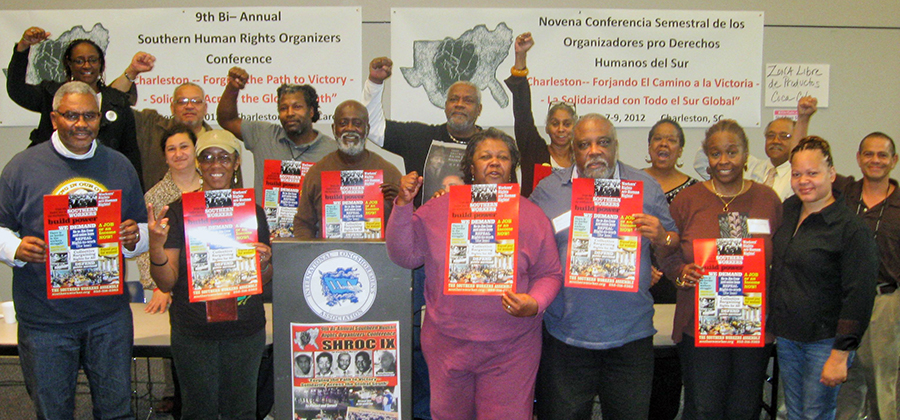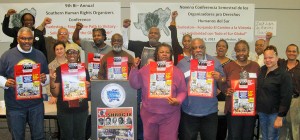

A resolution adopted at Southern Human Rights Organizers Conference held in Charleston, S.C., at a ILA Local 1422 Hall Dec. 9, read in part: SHROC stands in solidarity with the ‘ILA in its negotiations for a fair contract for its more than 14,000 members representing thousands more families and communities who will be affected by the contract.’WW photo: Monica Moorehead


A resolution adopted at Southern Human Rights Organizers Conference held in Charleston, S.C., at a ILA Local 1422 Hall Dec. 9, read in part: SHROC stands in solidarity with the ‘ILA in its negotiations for a fair contract for its more than 14,000 members representing thousands more families and communities who will be affected by the contract.’
WW photo: Monica Moorehead
Just days before a potential strike by more than 14,500 workers at 14 ports along the Eastern U.S. and the Gulf coasts, the International Longshoremen’s union and the U.S. Maritime Alliance (USMX) — the port bosses — announced another temporary extension of their collective bargaining agreement until Feb. 6 as negotiations continue. The previous extension would have expired at midnight on Dec. 29.
The threat of a strike by the ILA, which would be the first on the East Coast since 1977, sent shockwaves through big business. A group of more than 100 business owners, along with Florida Gov. Rick Scott, sent a letter in early December to President Obama, calling on him to invoke powers granted to the president in the 1947 Taft-Hartley Act that would allow him to stop the strike.
President George W. Bush invoked these powers in 2002 to force locked-out International Longshore and Warehouse Union to work West Coast holiday cargo.
The workers on the docks who move containers off ships from across the world work at a critical juncture in the global capitalist economy and play a crucial role in the international movement of commodities and goods. Many of these containers hold goods destined for the shelves of corporations like Walmart, Kmart, and Home Depot, while others contain raw materials like lumber, rubber and other commodities.
Last year alone, these 14 East and Gulf coast ports — from Boston to Baltimore; Wilmington, N.C., to Savannah, Ga.; and Miami to Houston — handled 110 million tons of cargo. In 2011, more than $208 billion worth of commodities went through the Port of New York and New Jersey, making it the biggest port on the East Coast and the third largest in the country.
At the core of the ongoing impasse in contract negotiations is the USMX’s demands for big concessions from the ILA on the key issues of what’s known as the container royalty fee and the Master Contract Wage Scale, including a guaranteed eight-hour workday. USMX wants to cap and eventually eliminate the royalty fees. In a release issued on Dec. 27 announcing the latest temporary extension of the collective bargaining agreement, the ILA announced some progress in negotiations around the central issue of the container royalty fee.
Containerization and automation
Throughout the course of the negotiations, the USMX has waged a vicious propaganda campaign against the dockworkers over the issue of wages and capping the container royalties, attempting to portray the workers as being “overpaid.” This flimsy line is taken right out of every boss’s playbook during a union struggle, and is merely cover for the USMX’s efforts to squeeze even more profits off the backs of the workers.
In the 1960s, there were nearly 35,000 dockworkers at the Port of New York and New Jersey. Today, there are just 3,500. The same is true at ports up and down the coast.
This dramatic drop is due to the introduction of standardized, 20- to 40-foot steel containers that brought along with it many other forms of automation. This led to mass reductions in the number of workers on the ports, along with cuts in working hours for those that remained.
The ILA won the container royalty fee in the 1960s. The fee is a small amount that is collected based on the amount of tons of cargo that ILA members handle, that is then distributed back out to the workers.
The royalty fee allows workers to keep a small share of the enormous profits that the bosses are reaping. Due to the dramatic increase in the amount of cargo that can be moved at one time, containerization and automation have wiped out thousands of jobs on the ports. Because of the technological developments associated with containerization, tons of goods that used to require many workers to handle are now moved by relatively few. Capping or eliminating the royalty fee would significantly reduce workers’ wages.
Dockworkers’ specific experience with containerization is but another example of the general developments workers have faced across industries and sectors over the past several decades. The bosses have introduced greater and greater technological changes, increasing labor productivity. Rather than these developments improving workers’ conditions, across the board they have driven down wages in the bosses’ continual quest for higher profits.
In 2011, a record $51.4 billion in cargo passed through Baltimore’s public and private marine terminals, 24 percent more than in 2010. In just the first six months of 2012, Baltimore’s public terminals handled 4.8 million tons of cargo, a 10 percent increase over the same period in 2011 and a record for the port.
Also in 2011, a record 461 ships moved a total of 4.4 million tons of goods through the Port of Wilmington, N.C.
Despite the USMX bosses and corporations’ huge cuts in the workforce, the workers are moving more goods than ever before.
The ILA reported that 15 workers were killed on the job this year alone after being crushed by containers, run over by forklifts, or from other injuries they sustained from this dangerous work. Speedups associated with automation and containerization undoubtedly exacerbate the dangers.
The Panama Canal’s expansion is expected to bring even more ships to the East Coast ports. With the still deepening capitalist economic crisis and the national offensive by bosses against workers throughout the country, the USMX is expected to try and take back what the union had won regarding the container royalty fee and wages.
But the ILA has so far shown its determination to fight on these central issues.
Where does the struggle go from here?
A potential coastalwide strike by the ILA would have huge implications for the U.S. labor movement, especially in this period. This struggle deserves continued attention as the new deadline of Feb. 6 approaches.
Saladin Muhammad on the talks
“The current negotiations between the ILA and the Maritime Alliance are critical for the future of the U.S. labor movement in terms of resisting imposition in the collective bargaining process,” said Saladin Muhammad, coordinator of the Southern Workers Assembly. “In addition to the corporate strategy to get states across the country to enact right-to-work laws, the call by the Florida governor for President Obama to impose Taft-Hartley, placing restrictions on the ILA’s right to strike, is part of the corporate strategy to weaken the power of the labor movement and to keep it in a position of concessionary and austerity bargaining.
“As U.S. and global corporations seek to maximize profits and maintain the dominance of the capitalist system, they must have a global supply chain to import, export, transport and warehouse raw materials, food products and finished goods to domestic and global markets,” Muhammad continued. “The longshore workers represent a key part of the global capitalist supply chain, and a decisive organized sector of the working class in the struggle against the abuses of the capitalist system against the workers.”
The Southern Workers Assembly has also recently released a petition calling on President Obama not to invoke Taft-Hartley in the event of a strike by the ILA. You can sign that petition at this address: southernworker.org/ilarighttostrikepetition/
The following updated article was originally posted on April 3, 2024. This April 4 will…
Boston Protesters gathered outside the Roxbury Crossing T-Station near the Islamic Society of Boston Cultural…
Over 175 people demonstrated in Philadelphia on March 31, taking to the streets from 30th…
Download the PDF. Download B&W version. Don't buy cars from Nazis Tesla 'smells like fascism'…
Portland, Oregon Fifteen groups endorsed the rally and march in Portland, Oregon, on March 30,…
Hundreds of people — including the marching band BABAM (the Boston Area Brigade of Activist…